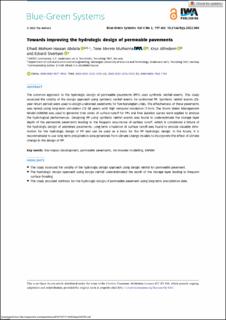Towards improving the hydrologic design of permeable pavements
Peer reviewed, Journal article
Published version
Permanent lenke
https://hdl.handle.net/11250/3038173Utgivelsesdato
2022Metadata
Vis full innførselSamlinger
- Publikasjoner fra CRIStin - SINTEF AS [5801]
- SINTEF Community [2247]
Sammendrag
The common approach to the hydrologic design of permeable pavements (PPs) uses synthetic rainfall events. This study assessed the validity of the design approach using synthetic rainfall events for undrained PP. Synthetic rainfall events (25-year return period) were used to design undrained pavements for five Norwegian cities. The effectiveness of these pavements was tested using long-term simulation (12–30 years) with high temporal resolution (1 min). The Storm Water Management Model (SWMM) was used to generate time series of surface runoff for PPs and flow duration curves were applied to analyse the hydrological performances. Designing PP using synthetic rainfall events was found to underestimate the storage layer depth of the permeable pavements leading to the frequent occurrence of surface runoff, which is considered a failure of the hydrologic design of undrained pavements. Long-term simulation of surface runoff was found to provide valuable information for the hydrologic design of PP and can be used as a basis for the PP hydrologic design. In the future, it is recommended to use long-term precipitation data generated from climate change models to incorporate the effect of climate change in the design of PP.

